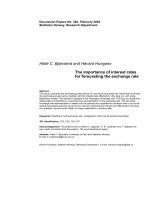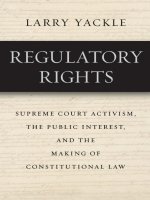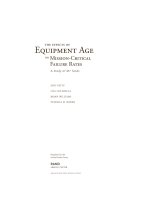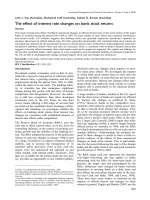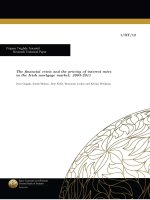the behaviour of interest rates
Bạn đang xem bản rút gọn của tài liệu. Xem và tải ngay bản đầy đủ của tài liệu tại đây (563.18 KB, 31 trang )
Copyright 2011
Pearson Canada Inc.
5 -
1
Chapter 5
The Behaviour of Interest Rates
Copyright 2011
Pearson Canada Inc.
5 -
2
Determinants of Asset Demand
1. Wealth - the total resources owned by the individual,
including all assets
2. Expected Return - the return expected over the next
period on one asset relative to alternative assets
3. Risk - the degree of uncertainty associated with the
return on one asset relative to alternative assets
4. Liquidity - the ease and speed with which an asset can
be turned into cash relative to alternative assets
Copyright 2011
Pearson Canada Inc.
5 -
3
Theory of Asset Demand
1. The quantity demanded of an asset is positively
related to wealth.
2. The quantity demanded of an asset is positively
related to its expected return relative to alternative
assets.
3. The quantity demanded of an asset is negatively
related to the risk of its returns relative to
alternative assets.
4. The quantity demanded of an asset is positively
related to its liquidity relative to alternative assets.
Copyright 2011
Pearson Canada Inc.
5 -
4
Supply and Demand for Bonds I
•
Bond Demand: At lower prices (higher interest
rates), ceteris paribus, the quantity demanded
of bonds is higher—an inverse relationship.
•
Bond Supply: At lower prices (higher interest
rates), ceteris paribus, the quantity supplied of
bonds is lower—a positive relationship.
Copyright 2011
Pearson Canada Inc.
5 -
5
Supply and Demand for Bonds II
Copyright 2011
Pearson Canada Inc.
5 -
6
Derivation of Bond Demand Curve
i = RET
e
= (F-P)/P
P=$950
i=($1000 - $950)/$950 = 0.053 = 5.3%
B
d
= $100 billion
Copyright 2011
Pearson Canada Inc.
5 -
7
Market Equilibrium
•
Occurs when the amount that people are willing to
buy (demand) equals the amount
that people are willing to sell (supply) at a given price.
•
B
d
= B
s
determines the equilibrium (or market clearing)
price and interest rate
•
When B
d
> B
s
excess demand price will rise and
interest rate will fall
•
When B
d
< B
s
excess supply price will fall and
interest rate will rise
Copyright 2011
Pearson Canada Inc.
5 -
8
Shifts in the Demand for Bonds I
•
Wealth - in an expansion with growing wealth, the demand curve
for bonds shifts to the right
•
Expected Returns - higher expected interest rates in the future
lower the expected return for long-term bonds, shifting the
demand curve to the left
•
Expected Inflation - an increase in the expected rate of inflations
lowers the expected return for bonds, causing the demand curve
to shift to the left
•
Risk - an increase in the riskiness of bonds causes the demand
curve to shift to the left
•
Liquidity - increased liquidity of bonds results in the demand
curve shifting right
Copyright 2011
Pearson Canada Inc.
5 -
9
Shifts in the Demand for Bonds II
Copyright 2011
Pearson Canada Inc.
5 -
10
Shifts in the Supply of Bonds I
•
Expected profitability of investment
opportunities - in an expansion, the supply
curve shifts to the right
•
Expected inflation - an increase in expected
inflation shifts the supply curve for bonds to
the right
•
Government activities - increased budget
deficits/surpluses shift the supply curve to the
right/left
Copyright 2011
Pearson Canada Inc.
5 -
11
Factors that Shift the Supply Curve of Bonds
Copyright 2011
Pearson Canada Inc.
5 -
12
Shifts in the Bond Supply Curve
Copyright 2011
Pearson Canada Inc.
5 -
13
Interest Rate Changes from Expected Inflation I
The Fisher Effect:
•
Increases in expected inflation B
s
shifts to
right
•
Increases in expected inflation B
d
shifts right
•
At the new equilibrium, bond prices have fallen
and the interest rate has increased.
Copyright 2011
Pearson Canada Inc.
5 -
14
Interest Rate Changes from Expected Inflation II
Copyright 2011
Pearson Canada Inc.
5 -
15
Response to a Business Cycle Expansion I
During a business cycle expansion:
•
Income and Wealth are increasing leading to
an increase in bond demand.
•
The supply of bonds also increases as firms are
more willing to borrow.
•
This leads to an increase in the equilibrium
interest rate
Copyright 2011
Pearson Canada Inc.
5 -
16
Response to a Business Cycle Expansion II
Copyright 2011
Pearson Canada Inc.
5 -
17
Business Cycles and Interest Rates
Business cycle expansions lead to increased interest rates
Copyright 2011
Pearson Canada Inc.
5 -
18
Response to a Lower Savings Rate
Copyright 2011
Pearson Canada Inc.
5 -
19
Liquidity Preference Framework I
•
Equilibrium interest rates are determined by
the supply and demand for money
•
Two ways to hold wealth: money and bonds
•
Total wealth equals total amount of money and
bonds.
B
s
+ M
s
= B
d
+M
d
Copyright 2011
Pearson Canada Inc.
5 -
20
Liquidity Preference Framework II
Rearrange terms:
B
s
- B
d
= M
d
– M
s
If the bond market is in equilibrium then the
money market must also be in equilibrium
Copyright 2011
Pearson Canada Inc.
5 -
21
Liquidity Preference Framework III
Copyright 2011
Pearson Canada Inc.
5 -
22
Shifts in the Demand for Money
•
Income Effect - a higher level of income causes
the demand for money at each interest rate to
increase and the demand curve to shift to the
right
•
Price-Level Effect - a rise in the price level
causes the demand for money at each interest
rate to increase and the demand curve to shift
to the right
Copyright 2011
Pearson Canada Inc.
5 -
23
Shifts in the Supply of Money I
•
Assume that the supply of money is controlled
by the central bank.
•
An increase in the money supply engineered by
the Bank of Canada
will shift the supply curve for money to the
right.
Copyright 2011
Pearson Canada Inc.
5 -
24
Shifts in the Demand and Supply of Money II
Copyright 2011
Pearson Canada Inc.
5 -
25
Changes in the Demand for Money



